

Vitamin C(L-ascorbic acid)The cure for scurvy.
Paul May
Molecule of the Month - July 2017. |
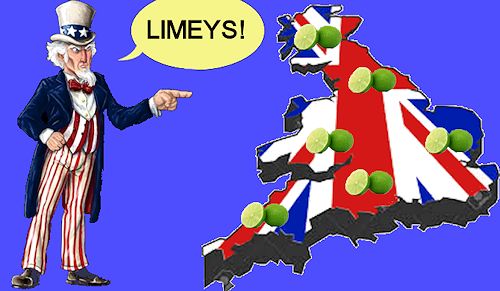 |

This is a slang term which originated around 1850 and was originally an insult directed by American sailors at British Royal Navy sailors, who they called lime-juicers (later shortened to limeys) because they added lemon or lime juice to their rations to prevent scurvy. Nowadays it is no longer considered an insult, and is used by Americans to describe anyone from Great Britain, not just sailors.
 What’s scurvy?
What’s scurvy?A few hundred years ago scurvy was a disease that was responsible for more deaths at sea than piracy, shipwreck and all other illnesses combined. It caused an agonizing death, which began with bleeding gums, loose teeth, and the reopening of old wounds. It was the famous disease of pirates, and was nicknamed the grey death. But no-one knew what caused it.
No-one knew for sure, but it was known that it occurred whenever people were prevented from eating fresh plant food or animal flesh for long periods of time, such as sailors trapped on a ship for many months crossing the oceans. In 1499, the explorer Vasco da Gama lost 116 of his crew of 170, and in 1520, Magellan lost 208 out of 230, mainly due to scurvy. In 1744, a British explorer by the name of George Anson took several ships to the South Seas on a voyage of discovery and plunder. He returned after 4 years with a huge amount of treasure, but 4 out of 5 ships had been lost and 1300 sailors died (2/3rd of the entire complement), again, mostly to scurvy. Anson was later promoted to First Lord of the Admiralty, and was determined to try to prevent such disasters happening to sailors again. He instigated a policy of supplying Royal Navy fleets in home waters with fresh food, but this only worked for ships close to shore. Those far out at sea on long explorations still succumbed to the dreaded disease because there was no way of storing and preserving fresh food for long periods of time.
No. Land scurvy had been known for centuries, occurring during famines, epidemics and sieges, as well as in prisons and army camps. But it was the Age of Discovery and sailing ships that really brought scurvy to the attention of the public. In the 300 years up to 1800 it is estimated that scurvy killed at least 2 million sailors.
Eventually. The first attempt to scientifically study the cause of scurvy was by James Lind, a Scottish ship's surgeon in the Royal Navy. In May 1747, in what is considered to be the first occurrence of a controlled scientific experiment, Lind provided some sailors on board ship with two oranges and one lemon per day on top of their normal rations, while the other sailors had just their normal rations supplemented with cider, vinegar, sulfuric acid or seawater. The first group remained well, while the second group all contracted scurvy, proving that citrus fruits prevented the disease. It took a few years' persuasion, but eventually the British Navy adopted the practice of taking lemons (or limes) on board ships which drastically cut down the instances of scurvy.
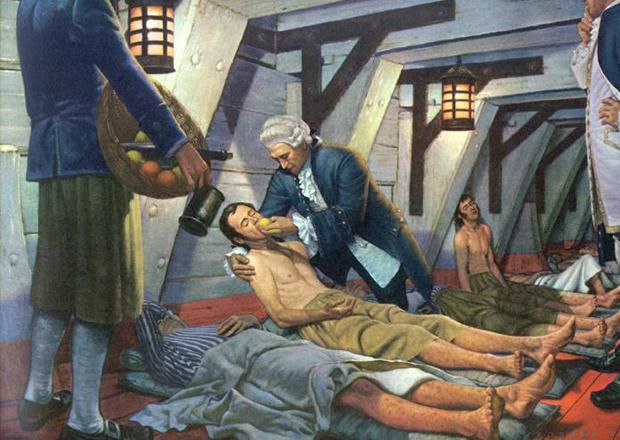
James Lind administering lemons to sailors afflicted with scurvy.
(Source: http://www.taussmarine.com/seyirdefteri/index.php/denizcilerde-gorulen-hastaliklar/)
Yes. Although many fresh foods were shown to combat scurvy, very few could be stored for months on board a ship. But lemons and limes (the names were used indistinguishably at the time) worked best because their juice could be mixed with the sailors' daily rations of rum and so last a long time. The Royal Navy switched to limes because they came from the British colonies in the West Indies and so were cheaper than lemons (which came from Europe or European colonies). This was a mistake because the West Indian varieties of limes were actually far less effective as they had a much lower content of the crucial anti-scurvy factor (which hadn’t yet been identified). In fact, so many Royal Navy sailors started to get scurvy again, even though they were eating limes, that the whole idea of citrus fruits preventing scurvy was called into question, and Lind's work very nearly undone.
It became known as ascorbic acid, derived from the word antiscorbutic (against scurvy), and nowadays is more commonly known as vitamin C.
 Why was it so hard to find?
Why was it so hard to find?The problem was that scurvy appeared to be an almost exclusively human illness. At the time, no other animals had ever been seen to show symptoms of scurvy. Without being able to test theories on animals (especially mammals) with scurvy, progress was painfully slow. The breakthrough came in 1907, when two Norwegian physicians (Axel Holst and Theodor Frølich) were studying the disease beriberi (another disease caused by a dietary deficiency) in the sailors in the Norwegian fishing fleet. Rather than experiment upon the sailors directly, they wanted to do so on a more expendable creature, preferably a mammal. They chose guinea pigs, which they fed with a diet of grains and flour in an attempt to give them beriberi. But instead of inducing beriberi (as it had done previously in pigeons), the diet produced symptoms of scurvy. It turns out that guinea pigs were a very lucky choice for the experiment because they are one of the only mammals apart from humans (and some apes) that cannot biosynthesis their own vitamin C and so can contract scurvy with poor diet. More importantly, Holst and Frølich found they could cure the guinea-pig scurvy by adding citrus fruits to their diet, just as in human cases. Now that scurvy could be studied in an animal, progress was more rapid.
.jpg) |
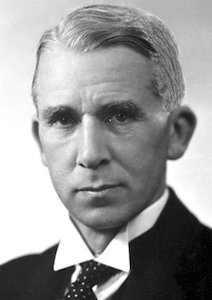 |
| Albert Szent-Györgyi in 1917 was awarded the 1937 Nobel Prize in Medicine for his role in discovering vitamin C. |
Norman Haworth from the University of Birmingham UK shared the 1937 Nobel Prizein Chemistry for synthesising vitamin C. |
In 1932, the antisorbutic agent was isolated, first from animal adrenal glands, then from citrus fruits, and finally from red peppers, and given the name L-ascorbic acid. The people credited with this were the teams led by the Hungarian chemist Albert Szent-Györgyi who isolated what he originally called 'hexanuric acid' (later renamed L-ascorbic acid) and a team at Birmingham University in the UK led by Norman Haworth who successfully synthesised it from starting reagents. The term vitamin had already been coined in 1912 by the Polish biochemist Casimir Funk, to mean the non-mineral micronutrients that are essential to health. The word 'vitamin' is a blend of ‘vital’ and 'amines' because Funk thought that all they were all amines. It wasn’t long before ascorbic acid became known as vitamin C (being the third vitamin to be discovered after A and B), even though, ironically, it turned out not to be an amine, and didn’t even contain a nitrogen atom.
It has a number of vital functions which maintain the smooth running and integrity of bodily processes. Because humans can’t synthesis their own vitamin C, they obtain it by eating fresh foods. Generally, it takes about 3 months without fresh food to reduce the body’s ascorbic acid to the level at which scurvy appears. (This is roughly the same time it takes a sailing ship to go from Europe to the Pacific or Indian Oceans).
Vitamin C is an antioxidant, reacting with and removing free radicals which are the by-product of cell metabolic activity. Free radicals are a problem because they are highly reactive, and if not removed they attack healthy cells and damage or kill them. So, a major role of vitamin C is to clean up the cells, rather like a vacuum cleaner, removing the hazardous detritus because it can cause any harm.
Under normal biological pH conditions, ascorbate acid loses a proton to become the ascorbate ion, which is particularly stable due to electron delocalisation. Ascorbate is special because it can be oxidised by loss of only one electron, with the semidehydroascorbate radical that is formed also being particularly stable due to the same electron delocalisation effect. Transferring only one electron is key, because that's exactly what is needed to destroy harmful free radicals such as ·OH and ·OR.
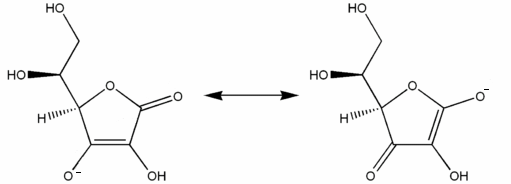 |
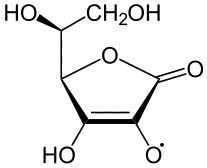 |
| The ascorbate ion is resonance stabilised. | The semidehydroascorbate radical is also resonance stabilised in a similar way. |
A typical reaction with a free radical such as ·OR would be:

An electron is transferred from the ascorbate ion to the free radical, turning it into its less harmful anion, which is then neutralised by transfer of a proton to form a harmless alcohol (ROH). The oxidized forms of ascorbate, including the semidehydroascorbate radical, are relatively unreactive and so do not cause cellular damage. In later steps, the fully oxidised ascorbate is converted back into vitamin C in a series of enzyme reactions.
And that's the cause of scurvy?Not really. Many of the symptoms of scurvy result from the loss of a second important role for vitamin C. This is to assist enzymes in the production of collagen – which is vital to ‘glue’ cells together and which acts as the scaffold in the body, especially in the skin, bones and cartilage. Without collagen, cartilage would disappear from joints, bones would become brittle and fragile, and wounds would not heal. Indeed, people in the latter stages of scurvy were reported to rattle and creak when they moved! Collagen glues the skin together, so without this the skin becomes weak leading to sores and wounds which never heal. Vitamin C also helps to recycle a molecule called tetrahydrobiopterin, which is needed by several key enzymes. One of these generates nitric oxide which diffuses out of the cells lining arteries and capillaries into the surrounding muscle, enabling these blood vessels to dilate when required. With loss of collagen, the blood-vessel walls become permeable, and begin to leak fluid. Vitamin C can prevent some of this leakage. The symptoms of this are shown in the early stages of scurvy by blood blisters which form around hair follicles, and later by ulcers on the legs and then bleeding from the muscles around the bones which turn the bones black. Samuel Taylor Coleridge wrote about this in his famous poem The Rime of the Ancient Mariner (1798 version). |
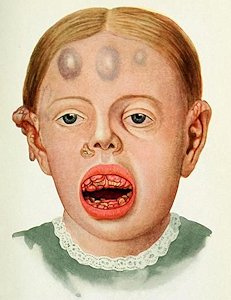 Scurvy victims often lose their teeth, the cartilage in the ears and nose degrades, and they get blisters and ulcers on the skin. |
Yes, his description of the character of Death is almost identical to that of a cadaver killed by scurvy:
His bones were black with many a crack,
All black and bare I ween. Jet black and bare.
And we’re not done yet. There is a fifth crucial function for vitamin C; it is required in the synthesis of dopamine (MOTM Oct 2008) and serotonin (MOTM April 2005), which are neurotransmitters vital for the correct function of nerves and the brain. Sailors with scurvy often experienced hallucinations, personality changes, and feelings of intense joy or sorrow. Senses became heightened, sights became dazzling, smells became exquisite or disgusting, sounds became vibrant, and tastes overwhelming. There are many reports of sailors with scurvy - when they were finally brought ashore - dropping dead at the devastatingly joyful sight of fresh food. Or dying of ‘rapture’ when they finally tasted an orange.
 Is scurvy a problem today?
Is scurvy a problem today?Scurvy is extremely rare nowadays, though it can sometimes be found in individuals who are severely malnourished, people living in poverty or individuals addicted to drugs or alcohol. There have also been reports of scurvy in children in war zones, such as the current conflict in Syria.
Not really. Most people who eat a balanced diet with fresh fruit and vegetables regularly will easily get enough vitamin C to prevent scurvy. Indeed, the extra dosage from supplements may even be harmful.
The amount of vitamin C in supplements can be many times higher than you’d get from a normal healthy diet, so taking too many pills is an easy way to overdose on vitamin C. This can have negative effects on your body, such as cause diarrhoea and bloating, and too much vitamin C has even been linked to the formation of kidney stones. As a result, most physicians suggest that people on dialysis and people who have a disposition to form kidney stones should not take vitamin C supplements. But vitamin C supplements may be useful for people suffering from anaemia, because it increases the amount of iron absorbed into the body from ingested food sources.
This is a common belief that originated from the famous scientist Linus Pauling, who is the only person ever to win two unshared Nobel prizes, one for Chemistry (1954) and the other for Peace (1962). Although his contributions to chemical theory are undisputed, in his later years he began to dabble in healthcare, and his approach became decidedly unscientific. It was Pauling who is largely responsible for the widespread misbelief that high doses of vitamin C are effective against colds and other illnesses. In 1970, Pauling proposed in his book Vitamin C and the Common Cold that taking 1,000 mg of vitamin C daily (~20 times the recommended daily intake for a healthy diet) would reduce the occurence of colds by 45% for most people, while others needed even larger amounts. He revised the book in 1976 and retitled it Vitamin C, the Common Cold and the Flu, and this time suggested even higher dosages. And in a third book, Vitamin C and Cancer (1979) he claimed that high doses of vitamin C may even be effective against cancer.
 |
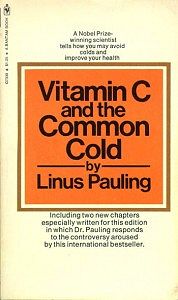 |
| Linus Pauling | Pauling's first book on Vitamin C megadosage |
The problem is there was no evidence for any of these claims – they were pure speculation. At least 16 well-designed, double-blind studies have shown that supplementation with vitamin C does not prevent colds and, at best, may slightly reduce the symptoms, possibly resulting from an antihistamine-like effect. The studies showed that it is not necessary to take the high doses suggested by Pauling to achieve this slight reduction in symptoms, and that there is nothing to be gained by taking vitamin C supplements year-round in the hope of preventing colds.
And numerous double-blind tests using vitamin C on cancer patients also showed no effect. Although Pauling's claims about the miraculous cure-all properties of megadoses of vitamin C lacked the evidence needed for acceptance by the scientific community, they have become a sort of urban myth, and been accepted by large numbers of people. Because of Pauling's reputation, annual sales of vitamin C in the USA have topped hundreds of millions of dollars for many years. In a 2013 article, paediatrician Paul Offit wrote that although Pauling was "so spectacularly right" that he won two Nobel Prizes, Pauling's later assertions about the benefits of vitamin C supplements were "so spectacularly wrong that he was arguably the world's greatest quack."


![]() Back to Molecule of the Month page. [DOI:10.6084/m9.figshare.5260030]
Back to Molecule of the Month page. [DOI:10.6084/m9.figshare.5260030]